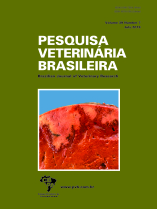 |
|
|
|
Year 2019 - Volume 39, Number 7
|

|
Clinical-epidemiological, anatomic-pathological, histochemical and immunohistochemical characterization of renal cystadenocarcinoma-nodular dermatofibrosis syndrome in 11 German Shepherd dogs, 39(7):499-509
|
ABSTRACT.- Thompson R.P.M., Lamego E.C., Melo S.M.P., Irigoyen L.F., Fighera R.A. & Kommers G. D. 2019. Clinical-epidemiological, anatomic-pathological, histochemical and immunohistochemical characterization of renal cystadenocarcinoma-nodular dermatofibrosis syndrome in 11 German Shepherd dogs. [Caracterização clínico-epidemiológica, anátomo-patológica, histoquímica e imuno-histoquímica da síndrome cistadenocarcinoma-dermatofibrose nodular em 11 cães Pastor Alemão.] Pesquisa Veterinária Brasileira 39(7):499-509. Laboratório de Patologia Veterinária, Departamento de Patologia, Universidade Federal de Santa Maria, Av. Roraima 1000, Camobi, Santa Maria, RS 97105-900, Brazil. E-mail: glaukommers@yahoo.com
Eleven cases of renal cystadenoma/cystadenocarcinoma-nodular dermatofibrosis syndrome (RCND) are described in German Shepherd dogs diagnosed from January 1994 to January 2018 at the Veterinary Pathology Laboratory of the “Universidade Federal de Santa Maria” (LPV-UFSM). The study sample was composed of eight male and three female dogs at a ratio of 2.67:1. Age ranged from six to 12 years (mean=8.7 years). The main clinical signs reported in descending order of frequency were multiple cutaneous nodules (nodular dermatofibrosis), dyspnea, anorexia, weight loss, recurrent hematuria, vomiting, and polydipsia. Results demonstrated that it is not always easy to clinically recognize this syndrome, but its peculiar anatomical-pathological characteristics allow safe diagnosis. Histologically, it was possible to detect all phases (cysts, papillary intratubular hyperplasia, and cystadenomas or cystadenocarcinomas) of a possible pathological continuum of the renal lesions. Uterine leiomyomas were observed in only one of the cases. Through histochemical techniques, it was possible to identify the presence of type I collagen in both cutaneous and renal lesions and consider its possible involvement in the pathogenesis of renal cystadenocarcinoma. Immunohistochemistry (IHC) showed partially satisfactory results in the staining of epithelial cells of renal cysts and neoplasms for pan-cytokeratin. |
| |
|
|
| |
|
 |